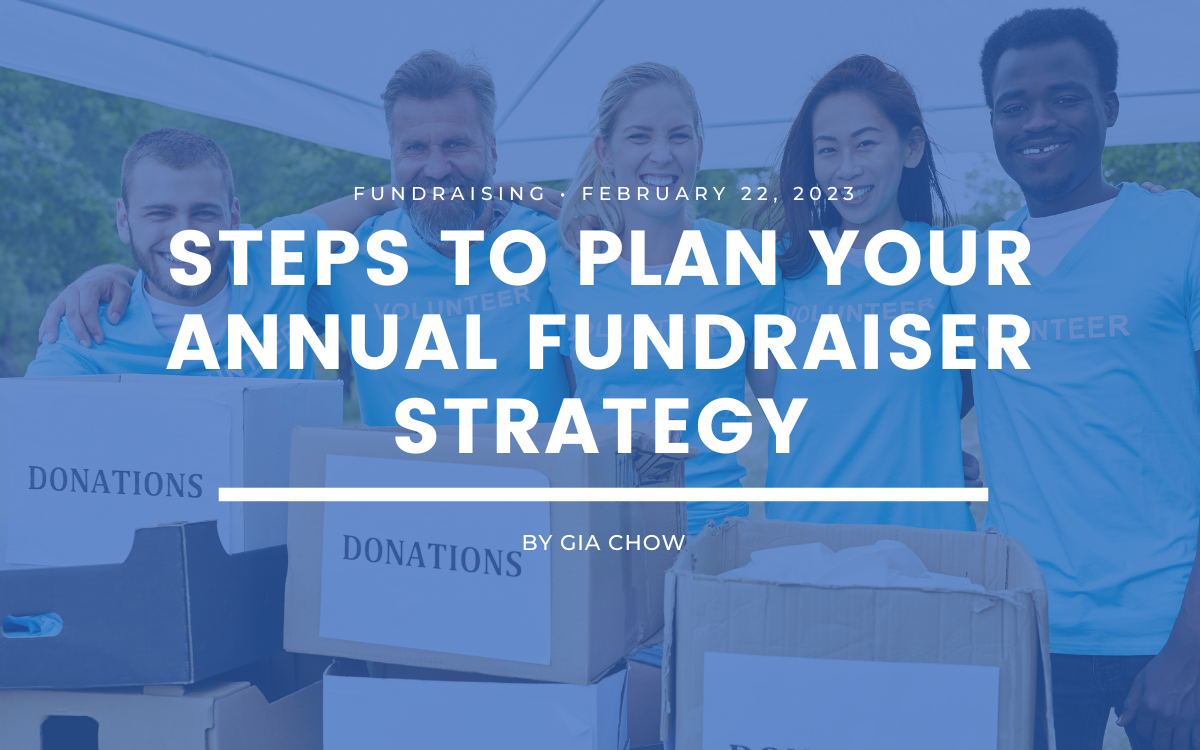Steps to Plan Your Annual Fundraiser Strategy
4 min to read ✭
Fundraising without a plan is like a ship without a rudder. Sure, you can still sail but you won’t have a clear direction. This year, don’t leave things to chance. Avoid last-minute scrambling and fundraise with confidence by taking stock of where you are and where you’re going with a killer annual fundraiser strategy.
What is an Annual Fundraiser Strategy
An annual fundraiser strategy is like a North Star for your organization. It’s a detailed plan that maps out your fundraising activities and goals for the year, keeping your team on the same page and accountable. Once you have a fundraiser strategy nailed down, you’ll have a better idea of what funding streams need to be fleshed out and what resources you need.
Every nonprofit is different so there isn’t a one-size-fits-all solution. Below, we’ve rounded up the steps that any nonprofit can take to start developing its own custom annual fundraiser strategy.
Step 1: Audit Current Fundraising Strategy
You may be eager to chart out your next annual fundraiser strategy but before you do that, take the time to review your current tactics and fundraising data. Take note of your organization’s strengths and weaknesses by answering questions such as:
- What were your most and least successful campaigns or activities?
- Of the least successful campaigns, what could be improved, and what should be scrapped?
- Who makes up your donor base?
- How are you tracking performance with key fundraising metrics?
- Which marketing channels have performed particularly well in regard to reaching your donor base?
Pro Tip: As you plan for the future, use a SWOT (strengths, weaknesses, opportunities, and threats) analysis to identify areas for growth and areas where you fell short. When done correctly, a SWOT analysis is a useful tool that strategically frames the backbone of your organization’s fundraising plan.
Step 2: Evaluate Against Current Trends
Once you’ve reviewed your organization’s fundraising history, the next step is to evaluate against current trends. The way we fundraise has evolved over time. To fundraise bigger and better than you did last year, it’s important to take into account what the current top fundraising trends are.
Ask yourself:
- Are your goals aligned with current fundraising trends?
- What are the opportunities there to test new strategies?
- What new offerings could you implement this year that would resonate with your donors?
- Is there something that new and current donors would appreciate?
Step 3: Set SMART Goals
Next, figure out how much you need to raise and what else you want to accomplish this year. Define specific, measurable, achievable, relevant, and time-bound goals that you need to keep your organization running using the SMART framework:
Specific: What will this goal accomplish?
Measurable: How will you know when you’ve successfully met your goal?
Achievable: Is it realistic and possible?
Relevant: Is the goal relevant to your mission?
Time Bound: When is your deadline to complete this goal?
Build Your Smart Goals With This Free Template
Step 4: Detail Your Methods
Now that you’ve outlined your goals, it’s time to list what fundraising tactics you plan to use. Describe exactly how you will be raising those funds and list any steps you need to take to make it happen. Include strategies such as:
- Crowdfunding or peer-to-peer campaigns
- Phone calls
- Direct mail
- Corporate matching gifts
- Email marketing
- Events
- Grants
- Recurring donations
- Endowments and planned giving
Step 5: Segment Your Audience
This step focuses on segmenting your audience. Oftentimes, you’ll see nonprofit segment donors by gift amount. They could have a segment for small-dollar donors, mid-level donors, and major donors. Of course, the dollar amount threshold for each category will vary from nonprofit to nonprofit. For example, smaller nonprofits may consider $500 as a major gift but for larger nonprofits, major gifts may start at $1,000. Refer to your organization’s fundraising data as a guide.
Are you interested in learning how to segment your audiences on your marketing channels? Talk To An Expert
Other Ways to Segment
Segmenting by gift amount is common but it doesn’t tell you much else aside from how much someone gave. While giving capacity is important, you’re not going to know how often they give (propensity), what they’re interested in (affinity), and why they chose your cause.
As an alternative to segmenting by gift amount, consider segmenting donors based on their level of involvement or their interests. When you can cater to the interests and intent of your donors, you can customize (and automate) their donor journey, making it that much more meaningful.
Step 6: Craft Your Key Messages
When it comes to fundraising, personalization is key. Your donors aren’t a monolith so ditch the generic template in lieu of tailored messaging.
Using the audience segments determined above, draft communication templates and messaging that is relevant to that specific group. These templates can include anything from thank you notes, emails, campaign pages, and appeal letters.
Step 7: Outline a Budget
Once you’ve got your key messages locked down, outline a budget to help determine what fundraising activities are reasonable based on how much you anticipate bringing in. You’ll want to include sources of committed income and all expenses.
Examples of income include grants, individual donations, sponsorships, merchandise sold, and matches. Depending on your goals, common expenses include things like ad spend, event space, materials, and more.
Step 8: Delegate Activities

Create a calendar and timeline to determine who’s doing what and when. Your timeline will be a roadmap for all your fundraising efforts and should include any deadlines and important dates. Divvy up and delegate activities as needed. Make sure to review your timeline with your team to ensure that it’s realistic and that no one is overly burdened with responsibilities.
Step 9: Analyze & Refine
The best way to figure out what works is simply to try until you find what works best for you. Don’t worry if you don’t get it right on the first try, it’s rare that anyone does. Instead, regularly analyzing your fundraising performance will help you determine what’s working and what’s not. If this is your first attempt at an annual fundraiser strategy, take this year to establish a baseline for future comparison next year.






